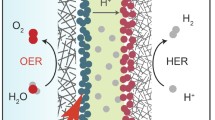Abstract
An electrode design with no use of three-phase boundary was investigated using palladium electrode. The hydrogen evolution rate of the palladium electrode cell using SrZr0.9Y0.1O3 − α electrolyte followed Faraday’s law up to 180 mA cm−2, and the anode and cathode overpotentials were significantly lower than those of a platinum electrode cell, suggesting that the palladium electrode is effective to improve the performance of the hydrogen-pumping cell using SrZrO3-based electrolyte. The rate-determining step (RDS) for electrode reaction was also investigated by changing the electrode morphology and hydrogen partial pressure, and it was suggested that the RDS of the anode is a reaction at electrode/electrolyte interface.








Similar content being viewed by others
References
Matsumoto H, Hamajima S, Iwahara H (2001) Electrochemical hydrogen pump using a high-temperature-type proton conductor: improvement of pumping capacity. Solid State Ionics 145:25–29
Matsumoto H, Shimura T, Iwahara H, Higuchi T, Yashiro K, Kaimai A, Kawada T, Mizusaki J (2006) Hydrogen separation using proton-conducting perovskites. J Alloy Compd 408–412:456–462
Matsumoto H, Iida Y, Iwahara H (2000) Current efficiency of electrochemical hydrogen pumping using a high-temperature proton conductor SrCe0.95Yb0.05O3-a. Solid State Ionics 127:345–349
Matsumoto H, Hamajima S, Yajima T, Iwahara H (2001) Electrochemical hydrogen pump using SrCeO3-based proton conductor—effect of water vapor at the cathode on the pumping capacity. J Electrochem Soc 148(10):D121–D124. doi:10.1149/1.1400121
Matsumoto H, Okada S, Hashimoto S, Sasaki K, Yamamoto R, Enoki M, Ishihara T (2007) Hydrogen separation from syngas using high-temperature proton conductors. Ionics 13(2):93–99. doi:10.1007/s11581-007-0080-4
Matsumoto H, Kudo T, Otake T, Horikiri F, Kaimai A, Yashiro K, Kawada T, Mizusaki J, Shimura T, Iwahara H, Watanabe M (2004) Hydrogen separation from reformed gases using high-temperature proton conductors. In: Chowdari BVR (ed) Proceedings of the 9th Asian conference on solid state Ionics: the science and technology of ions in motion: Jeju Island, Korea. World Scientific, Hackensack, pp 373–380
Sakai T, Matsumoto H, Kudo T, Yamamoto R, Niwa E, Okada S, Hashimoto S, Sasaki K, Ishihara T (2008) High performance of electroless-plated platinum electrode for electrochemical hydrogen pumps using strontium-zirconate-based proton conductors. Electrochimica Acta 53:8172–8177. doi:10.1016/j.electacta.2008.06013
Iwahara H, Esaka T, Uchida H, Maeda N (1981) Proton conduction in sintered oxides and its application to steam electrolysis for hydrogen production. Solid State Ion 3(4):359–363
Iwahara H, Uchida H, Maeda N (1983) Studies on solid electrolyte gas cells with high-temperature-type proton conductor and oxide ion conductor. Solid State Ion 11:109–115
Iwahara H, Yajima T, Hibino T, Ozaki K, Suzuki H (1993) Proton conduction in calcium, strontium and barium-zirconate. Solid State Ion 61:65–69
Iwahara H (1995) Technological challenges in the application of proton conducting ceramics. Solid State Ion 77:289–298
Uchida H, Maeda N, Iwahara H (1983) Relation between proton and hole conduction in SrCeO3-based solid electrolytes under water-containing atmospheres at high temperatures. Solid State Ion 11:117–124
Bonanos N, Ellis B, Mahmood MN (1991) Construction and operation of fuel cells based on the solid electrolyte BaCeO3:Gd. Solid State Ion 44:305–311
Stevenson DA, Jiang N, Buchanan RM, Henn FEG (1993) Characterization of Gd, Yb and Nb doped barium cerates as proton conductors. Solid State Ion 62:279–285
Nowick AS, Du Y (1995) High temperature protonic conductors with perovskite-related structures. Solid State Ion 77:137–146
Scholten MJ, Schoonman J, Miltenburg JCV, Oonk HAJ (1993) Synthesis of SrCeO3, BaCeO3, SrZrO3 and BaZrO3 and their reaction with CO2. In: Shinghai SC, Iwahara H (eds) Proceedings of the 3rd international symposium on solid oxide fuel cells, The Electrochemical Society Proceedings 93–4. The Electrochemical Society Inc., Pennington, pp 146–155
Müller J, Kreuer KD, Maier J, Matsuo S, Ishigame M (1997) A conductivity and thermal gravimetric analysis of a Y-doped SrZrO3 single crystal. Solid State Ion 97:421–427
Huang HH, Ishigame M, Shin S (1991) Proton conduction in the single crystals of Y-doped SrZrO3. Solid State Ion 47:251–255
Kreuer KD, St A, Münch W, Fuchs A, Klock U, Maier J (2001) Proton conducting alkaline earth zirconates and titanates for high drain electrochemical application. Solid State Ion 145:295–306
Marnellos G, Stoukides M (1998) Ammonia synthesis at atmospheric pressure. Science 282:98–100. doi:10.1126/science.282.5386.98
Marnellos G, Zisekas S, Stoukides M (2000) Synthesis of ammonia at atmospheric pressure with the use of solid state protonic conductors. J Catal 193:80–87. doi:10.1006/jcat.2000.2877
Ito N, Iijima M, Kimura K, Iguchi S (2005) New intermediate temperature fuel cell with ultra-thin proton conductor electrolyte. J Power Sources 152(1):200–203
Author information
Authors and Affiliations
Corresponding authors
Rights and permissions
About this article
Cite this article
Sakai, T., Matsumoto, H., Yamamoto, R. et al. Performance of palladium electrode for electrochemical hydrogen pump using strontium-zirconate-based proton conductors. Ionics 15, 665–670 (2009). https://doi.org/10.1007/s11581-009-0365-x
Received:
Revised:
Accepted:
Published:
Issue Date:
DOI: https://doi.org/10.1007/s11581-009-0365-x




